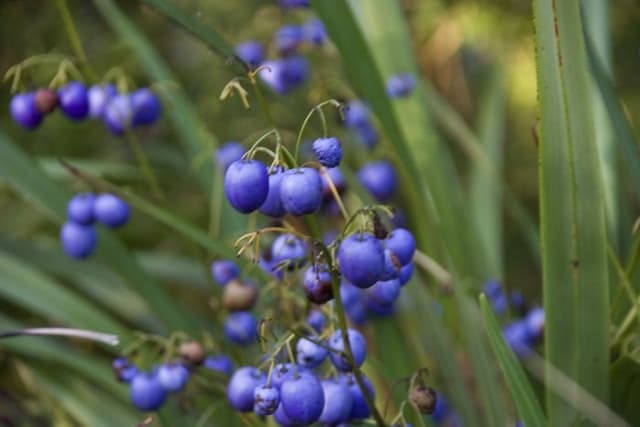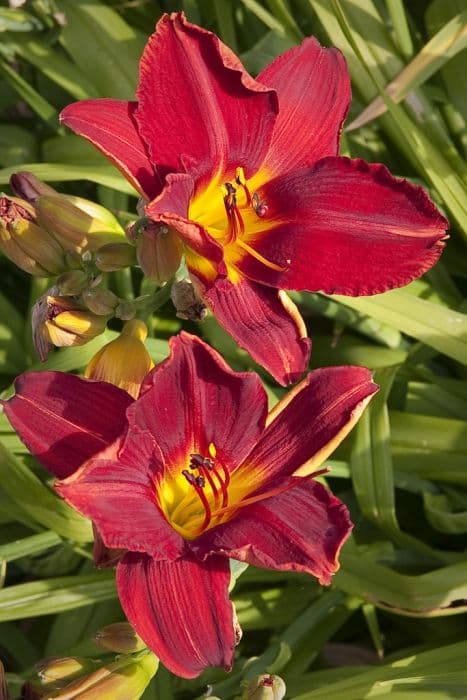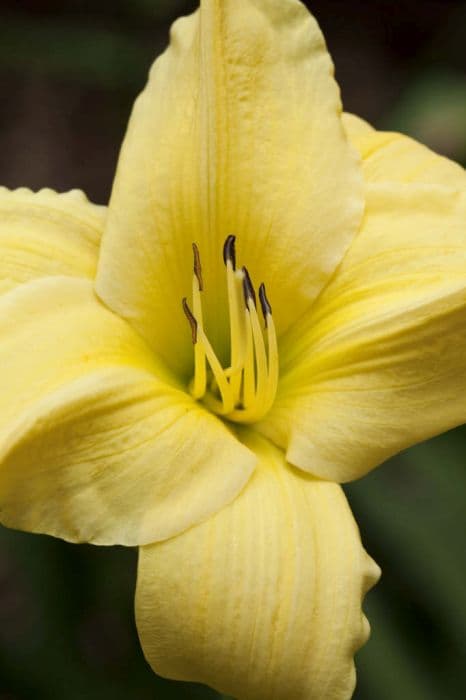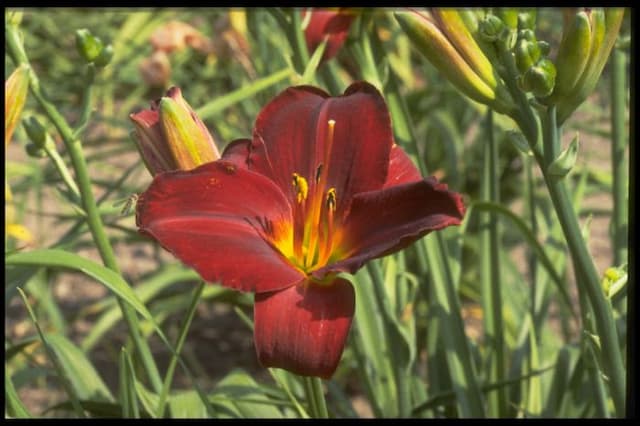Daylily Hemerocallis 'Christmas Is'

ABOUT
Hemerocallis 'Christmas Is', commonly known as the Daylily 'Christmas Is', is a perennial plant renowned for its colorful and attractive blooms. The distinctive flowers of this variety are known for their trumpet-like shape, featuring broad petals that flare outwards. The blooms typically showcase a deep, velvety red color, reminiscent of the festive tone associated with Christmas. The petals may have slightly ruffled edges, adding to their decorative appearance, and often display a subtle, lighter-colored midrib, providing a striking contrast against the rich red. The throat of the Daylily 'Christmas Is' flower is usually a lighter shade, often a pale yellow or green, which progressively merges into the dominant red of the petals. This transition adds depth and dimension to each blossom. The foliage of the Daylily 'Christmas Is' is composed of long, narrow, and arching leaves that are lush green in color, forming a dense and grassy clump. The leaves act as an elegant backdrop to the dramatic flowers. The Daylily's characteristic form is that of multiple flowers atop a tall and sturdy stalk, which rises above the foliage, giving the blooms prominence when they are in their full glory. These prominent blooms often appear in the summer months, and the Daylily 'Christmas Is' is known for its ability to produce a multitude of flowers over the season. The blossoms only last for one day each, hence the name "Daylily," but the plant compensates with a succession of flowers that open over several weeks, ensuring a prolonged display of its gorgeous red blooms.
About this plant
 Names
NamesSynonyms
Daylily
Common names
Hemerocallis 'Christmas Is'
 Toxicity
ToxicityTo humans
Hemerocallis, commonly known as the daylily, is not typically considered toxic to humans, and in fact, certain parts of the plant are sometimes eaten. However, it is always essential to exercise caution and ensure that you are correctly identifying plants, as consuming the wrong species can be harmful. The Hemerocallis variety named 'Christmas Is' should be treated with the same considerations. If there is any doubt about the identification or safety of the plant, it is best to avoid ingestion.
To pets
Daylilies, including Hemerocallis 'Christmas Is', are considered to be particularly toxic to cats. Ingesting even a small amount of any part of the plant can cause severe kidney damage, which can be fatal. Symptoms of daylily poisoning in cats may include vomiting, lethargy, inappetence, and signs of kidney failure such as decreased urination or anuria. Immediate veterinary care is crucial if ingestion is suspected. While daylilies are toxic to cats, they are not commonly known to be toxic to dogs or other household pets. However, as reactions can vary between individual animals, caution is still advised.
 Characteristics
CharacteristicsLife cycle
Perennials
Foliage type
Deciduous
Color of leaves
Green
Flower color
Red
Height
2 feet (0.61 meters)
Spread
2 feet (0.61 meters)
Plant type
Herb
Hardiness zones
3
Native area
Asia
Benefits
 General Benefits
General Benefits- Easy to Grow: The daylily is known for its hardiness and ease of cultivation, able to thrive in a variety of soil conditions and requiring minimal maintenance.
- Drought Tolerant: Once established, daylilies can withstand periods of drought, making them suitable for water-wise gardens.
- Pest Resistant: Daylilies are generally resistant to many pests and diseases, ensuring a garden with fewer chemical interventions.
- Long Blooming: They offer a long blooming season, often with multiple blooms over several weeks, providing lasting color in the landscape.
- Attraction for Wildlife: The bright, trumpet-shaped flowers of daylilies are enticing to pollinators such as bees and butterflies, enhancing biodiversity.
- Variety of Uses: Daylilies are versatile and can be used in borders, flower beds, as ground cover or in containers, offering flexibility in garden design.
- Propagation: They can be easily propagated by division, allowing gardeners to multiply their plants and share with others.
- Seasonal Interest: The foliage of daylilies adds texture and greenery to gardens, even when the plants are not in bloom.
- Soil Improvement: The root system of daylilies can help improve soil structure and prevent erosion in certain settings.
- Edible Parts: Certain parts of the daylily are edible and can be used in culinary dishes, though they should be consumed with caution and proper identification.
 Medical Properties
Medical PropertiesThis plant is not used for medical purposes.
 Air-purifying Qualities
Air-purifying QualitiesThis plant is not specifically known for air purifying qualities.
 Other Uses
Other Uses- The daylily 'Christmas Is' petals can be used to create a natural dye for fabrics, providing a range of colors from yellow to orange, depending on the mordant used.
- These plants can be planted as part of a strategy for erosion control due to their dense root system that stabilizes soil.
- Daylily flowers can be used as a natural food coloring in culinary creations to add a splash of non-toxic color.
- The fibrous roots of the daylily can be incorporated into homemade paper to add texture and visual interest.
- Daylilies can be used as a living mulch in gardens, where they suppress weeds while retaining soil moisture.
- These plants are suitable for creating floral waters or perfumed spritzers, when distilled, due to their delicate fragrance.
- Daylily stalks, once dried, can be used in the crafting of small, hand-made items, such as woven baskets or decorative objects.
- The blooms can be pressed and included in botanical art or to create natural patterns on textiles.
- The spent flower stalks can be cut and used as natural stirrers or skewers for summer barbecues or garnishes in drinks.
- Flower buds of the daylily can be pickled or candied to create unique gourmet edible treats.
Interesting Facts
 Feng Shui
Feng ShuiThe Daylily is not used in Feng Shui practice.
 Zodiac Sign Compitability
Zodiac Sign CompitabilityThe Daylily is not used in astrology practice.
 Plant Symbolism
Plant Symbolism- Embracing Change: Hemerocallis, commonly known as Daylily, symbolizes the acceptance and embrace of change because each bloom typically only lasts for one day.
- Motherhood: The Daylily is a Chinese symbol for motherhood due to its nurturing ability to keep producing flowers even when conditions are unfavourable.
- Forgetfulness: In Victorian flower language, the Daylily represents forgetfulness, possibly arising from the fleeting nature of its blossoms.
- New Beginnings: The Daylily signifies new beginnings as it brings forth fresh flowers each day, reminding us that every day is a new opportunity.
 Water
WaterDaylilies, including the Hemerocallis 'Christmas Is', should be watered deeply once a week during dry periods to encourage deep root growth. This usually translates to about 1 to 1.5 inches of water which could approximately be 0.623 gallons for a small-sized garden. During the active growth period in spring and summer, they may require more frequent watering, especially if the weather is particularly hot or dry. Consistency is key; the soil should be kept moist but not waterlogged. Overwatering can lead to root rot, so ensure proper drainage. In cooler months or during rainy seasons, reduce the watering frequency to account for lower evaporation rates and natural precipitation.
 Light
LightDaylilies, such as the Hemerocallis 'Christmas Is', thrive best in full sunlight to partial shade. An optimal spot for daylilies is where they can receive at least six hours of direct sunlight per day. If planted in too much shade, the amount and size of flowers may be reduced. However, in extremely hot climates, some afternoon shade can prevent the flowers from fading too quickly.
 Temperature
TemperatureDaylilies, including Hemerocallis 'Christmas Is', are quite adaptable to a range of temperatures but prefer moderate conditions. They can typically survive in temperatures as low as -30 degrees Fahrenheit during dormancy and can handle summer highs well above 90 degrees Fahrenheit. Ideally, they flourish in regions where the daytime temperatures are between 70 to 85 degrees Fahrenheit and nighttime temperatures drop slightly.
 Pruning
PruningPruning daylilies, including Hemerocallis 'Christmas Is', mainly involves removing spent flower stalks and dead foliage to promote healthy growth and aesthetics. This can be done throughout the blooming season to encourage reblooming. The best time for a more thorough pruning is in the late fall or early spring to remove old growth before new shoots emerge.
 Cleaning
CleaningAs needed
 Soil
SoilDaylilies thrive in moderately fertile, well-drained soil with a slightly acidic to neutral pH of 6 to 6.5. The best soil mix for daylilies would be a blend of loamy garden soil, compost, and a bit of sand to improve drainage. A balanced, slow-release fertilizer can be mixed into the soil to encourage robust growth.
 Repotting
RepottingDaylilies are not typically grown in containers and thus do not require frequent repotting. Instead, they are perennials best suited for garden beds. If grown in containers, repotting should be done every 2-3 years or when the plant outgrows the pot.
 Humidity & Misting
Humidity & MistingDaylilies are tolerant of a wide range of humidity conditions and do not require any special humidity considerations. They grow well in the ambient outdoor humidity levels found in their hardiness zones.
 Suitable locations
Suitable locationsIndoor
Ensure bright light and room to grow; avoid soggy soil.
Outdoor
Plant in full sun to partial shade in well-draining soil.
Hardiness zone
3-9 USDA
 Life cycle
Life cycleHemerocallis 'Christmas Is', commonly known as the Daylily 'Christmas Is', starts its life as a seed that germinates in spring to early summer in well-drained soil with adequate sunlight. The seedling emerges and develops into a young plant with slender, grass-like foliage and begins to establish a root system. As the plant matures, it forms a clump of foliage and an underground storage structure called a rhizome, which allows it to perennialize and survive through varying weather conditions. The Daylily 'Christmas Is' enters its flowering stage in late spring to early summer, where it produces a succession of large, trumpet-shaped, typically red or pink flowers on long stalks known as scapes, each bloom lasting only one day. After the flowering period, the plant sets seed which can disperse, starting a new generation, or the plant can propagate vegetatively by division of the rhizomes. As cold weather approaches, the foliage dies back, and the plant enters a period of dormancy over winter, only to resume growth the following spring.
 Propogation
PropogationPropogation time
Late summer to early fall
Propogation: The Hemerocallis 'Christmas Is', commonly known as the Daylily 'Christmas Is', is most commonly propagated by division, which is best done in spring or early fall. Division involves carefully digging up the plant and separating the clump into smaller sections, each with a few fans of leaves and a portion of the root system. This process rejuvenates the plants, as crowded clumps often begin to flower less prolifically. To propagate the Daylily 'Christmas Is', gardeners should gently pull the clumps apart by hand or cut them with a sharp knife or spade, ensuring each new section has at least one growing point or fan of leaves. These divisions can then be immediately replanted in the garden, spaced about 18 to 24 inches (approximately 45 to 60 centimeters) apart, to allow for growth and air circulation. The soil around the new divisions should be watered deeply to help establish the roots.









